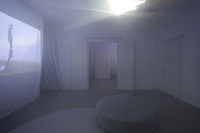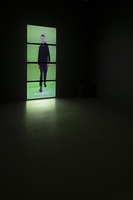All of Jan Kowal's activities are recorded in winter. Having lived with the changeability of the seasons since childhood, he finds tranquillity in the grey light of the day.
"And so the earth bends lower every day.
Therefore man will not gain wisdom
until he has survived his share of winters
in the kingdom of the earth."
A post-harvest crop or intercrop is the oldest way to fertilise the soil naturally. After the harvest is complete, we sow green plants to be cut, dug up and left behind. Such fertiliser naturally strengthens the soil before the main sowing and protects against weeds. When Jan Kowal was preparing for his thesis, his mother's small farm was in crisis. The artist could no longer think of creating more work detached from the family problems and felt the need to participate in the life of the farm. He wanted to bring from himself the skills and tools he uses every day in his artistic activities. It was not a need for spectacular actions, which we could here compare to the main sowing. His 'co-perception, radical hope and diagnosis of the atmosphere' were as stimulating to the farm as an after crop to the soil. In this way, the artist referred to the activities of the Slovenian group OHO from the late 1960s and their approach to nature. They worked in the conceptual sphere, provoking subtle interventions in nature bordering on land art, but also reflecting philosophically on the role of male and female artists in society. These activities led the OHO group to create something resembling a commune, called the Šempas Family in the countryside of western Slovenia. This was a form of withdrawal from the art world and an attempt to indulge in other forms of practising a creative relationship with nature. Without having to create a world closer to nature for himself, Jan Kowal merely returned to the place of his childhood.
In the exhibition, we accompany his voiceless Complaints, in the form of repetitive actions devoid of meaning. We witness Anti-Effects, utopian attempts of Action doomed to failure.
These acts, without effects, happen in a symbolic in-between. The in-between is a time without work, a time of peace, as described by Byung-Chul Han in his essay 'The Society of Fatigue'. The philosopher longs for a deep, contemplative attention to which the overactive ego has no access. According to Han, states of limbo elude the over-activity characteristic of a society in which we ourselves are our own inner oppressor with an eternal imperative for achievement, leading to self-exploitation. Meanwhile, it is 'deep boredom that is the culmination of spiritual relaxation' .
All of Jan Kowal's activities are recorded in winter. Their background is the landscape of the Polish countryside. It is not the idyllic landscape injected into us, full of idylls in vibrant light. His Complaints are filled with the soft winter light of the low-lying sun. Nevertheless, for the artist, winter is a period of solace. Having lived with the changeability of the seasons since childhood, he finds tranquillity in the grey light of the day.
Then nature sleeps. Underexposed man also sleeps.
Poland consists of 93% rural areas. Romanticism depicted the Polish countryside as an idyllic, harmonious land. Only in recent years have we begun to study the history of the countryside as a place of exploitation of compatriot by compatriot, but also as a place of oppression and resistance of the weakest. Jan Kowal's resistance to the merciless machinery of the economy, of which his family home is a victim, is a voiceless complaint in a 'grey hour'. The artist is not a romantic wanderer melancholic in a haze of uncertain ideas. His vision of the Polish countryside is mixed with the ridiculousness of human existence. Our hero (on whom too little light falls) enters and falls. He enters and falls. He enters and falls.
"On the edge of night and day, in the grey hour of pre-dawn - on uhtan - a quiet song rings out. In it, a painful complaint mingles with words of curse, and suppressed grief with a desire for revenge". This is how the Song of the Grey Hour begins the description of Old English elegies, metaphysical pieces, filled with sad reverie over the vicissitudes of fate. Existential, voiceless complaints are laced with the greyness of the day. The gloominess of the elegy is intertwined with its stifled colours deprived of the pre-dawn sun.
Jan Kowal (b. 1997) - in Piotrówka. Graduate of the Academy of Fine Arts in Katowice. He is interested in experimentation, where he looks for new ways of narration. He also works in painting and performance. In his actions, he confronts himself with the immediate environment of the village he comes from. He explores it in search of new meanings and interesting ways of telling stories. He likes to return to his village.
- Exhibition
- 11 February ‒ 24 March 2023
- artist: Jan Kowal
- curator: Katarzyna Kalina
- opening: 11.02. (Saturday), 19:00-21:00
- visual identity: Marcin Wysocki
- photo documentation: Marcin Wysocki







